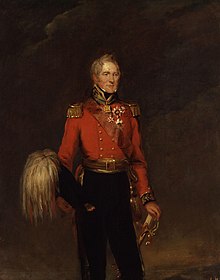Ormsby Vandeleur
Sir John Ormsby Vandeleur | |
|---|---|
 Sir John Ormsby Vandeleur | |
| Born | 1763 Kilrush, Ireland |
| Died | 10 December 1849 (aged 86) Dublin, Ireland |
| Allegiance | |
| Service/ | Cavalry, Infantry |
| Years of service | 1781–1849 |
| Rank | General |
| Battles/wars |
|
| Awards | Order of St. Vladimir, 2nd class Military Order of Max Joseph |
General Sir John Ormsby Vandeleur (1763 – 10 December 1849) was a British Army officer who fought in the
Biography
Vandeleur, born in 1763, was the son of Richard Vandeleur (died 1772) and Elinor, daughter of John Firman of Firmount. The Vandeleurs, of Dutch origin, came to Ireland in the seventeenth century, and settled at Kilrush, County Clare, where they became the principal landowners.[1] [a]
Vandeleur's received a commission as
In April 1794 Vandeleur went with his regiment to Flanders to serve under the Frederick, Duke of York, where he took part in the principal actions of the Flanders Campaign, and accompanied the army in its retreat across Holland to Bremen. On the embarkation of the British army for England in April 1795, Vandeleur remained with a small corps under General Dundas until December.[1]
In August 1796 he went to the
In October 1802 Vandeleur went with his regiment to India, and served as lieutenant-colonel with the local rank of colonel in command of a brigade of cavalry under Lord Lake in the Second Anglo-Maratha War 1803–1805. At the Battle of Laswari on 1 November 1803, Vandeleur turned the enemy's left flank and took two thousand prisoners, receiving the thanks of Lord Lake. He was similarly distinguished in November 1804 for the cavalry affair at Fathghar, where the Maratha chief Holkar was surprised and defeated. Equally brilliant were his charge and recapture of artillery at Afzalghar on 2 March 1805.[1]
In 1806 Vandeleur returned to England. On 16 April 1807, he exchanged into the 19th Light Dragoons, and on 25 April 1808 was promoted to be brevet colonel. On 4 June 1811 he was promoted to major-general, and appointed to command an infantry brigade of the Light Division in the Peninsular War.[1]
Vandeleur led the division, after
In October 1814 Vandeleur was appointed to the staff of the British army in Belgium. He was given the colonelcy of the
The 19th Light Dragoons were disbanded in 1820, and in 1823 Vandeleur was given the colonelcy of the
Family
Vandeleur married a daughter of the Rev. John Glesse in 1829 and the couple had two children, a son and a daughter Ellen who married Colonel Richard Greaves (for some twenty years assistant military secretary to the commander of the forces in Ireland, and afterwards colonel of the
Notes
- ^ His parents, Captain Richard Vandeleur, 9th lancers, of Rutland, Queen's County, and Elinor,[1] also had two daughters: Elizabeth who married into the Moore family and Ellen who married William Armstrong.
His grandparents on his father's side were John Vandeleur (died 1754) and Frances Ormsby. They had several children (who were Aunt and uncles to Vandeleur): Mary (died 1790), John Ormsby (died 1777), Crofton (died 1795).
A number of cousins served in the British army and three were killed in action. 87th Foot.[2]
- ^ a b c d e f g h i Vetch 1899, p. 97.
- ^ Scanlan 2010.
- ^ "No. 13525". The London Gazette. 7 May 1793. p. 370.
- ^ Vetch 1899, p. 98.
- ^ Vetch & Stearn 2008.
References
- Scanlan, Senan (4 June 2010), Vandeleurs of Kilrush, County Clare: Lineage of the Vandeleurs, County Clare, Ireland: Clare County Library, retrieved 1 March 2013
- doi:10.1093/ref:odnb/28063 (Subscription or UK public library membershiprequired.)
Attribution:
 This article incorporates text from a publication now in the public domain: Vetch, Robert Hamilton (1899), "Vandeleur, John Ormsby", in Lee, Sidney (ed.), Dictionary of National Biography, vol. 58, London: Smith, Elder & Co, pp. 97–98
This article incorporates text from a publication now in the public domain: Vetch, Robert Hamilton (1899), "Vandeleur, John Ormsby", in Lee, Sidney (ed.), Dictionary of National Biography, vol. 58, London: Smith, Elder & Co, pp. 97–98
- War Office Records;
- Despatches;
- Siborne's History of the Waterloo Campaign;
- Napier's Peninsular War;
- Thorn's Memoir of the War in India 1803–6;
- United Service Journal, 1849;
- Gent. Mag. 1850;
- Royal Military Calendar, 1820;
- private sources;
- Burke's Landed Gentry.
Further reading
- Fletcher, Ian (2005). Vittoria 1813: Wellington Sweeps the French from Spain. New York, NY: Praeger Publishers. ISBN 0-275-98616-0.
- Gates, David (2002). The Spanish Ulcer: A History of the Peninsular War. London: Pimlico. ISBN 0-7126-9730-6.
- ISBN 0-141-39041-7.
- ISBN 1-85367-276-9.
